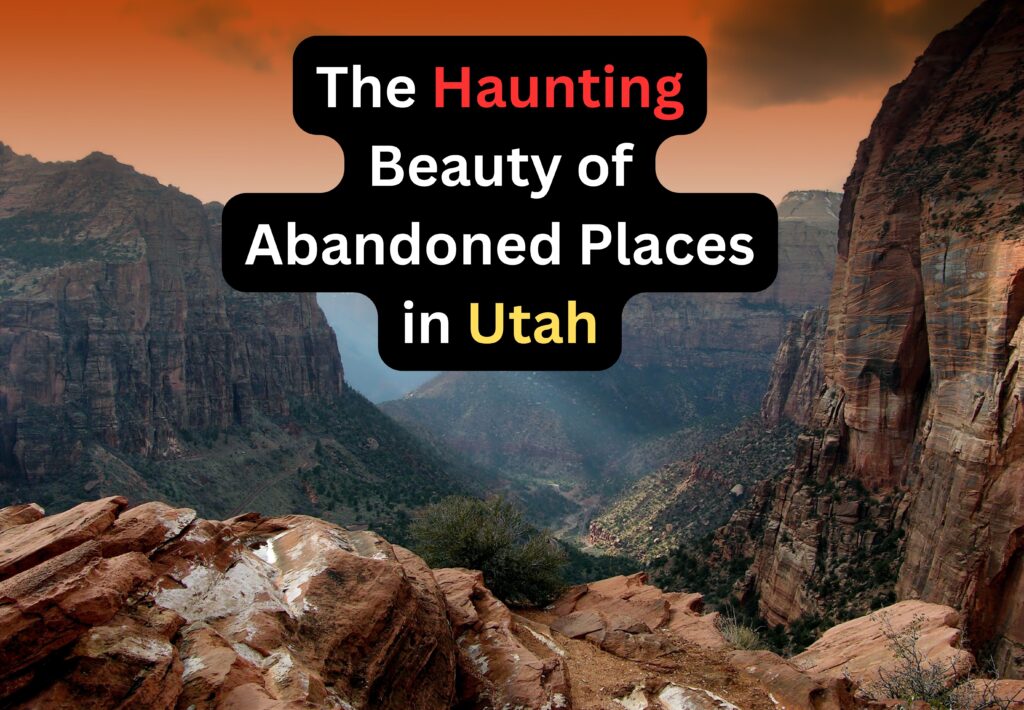Abandoned places, or as they are often referred to, “ghost towns“, and settlements free from inhabitants. These places, frozen in time, offer a unique glimpse into the past, serving as historical touchstones that narrate the stories of human endeavors, resilience, and eventual abandonment.
In Utah, there are several such abandoned places, each with its unique tale to tell. The state’s vibrant history, shaped by the gold rush, the railroad expansion, and the mining boom, has left behind a series of abandoned settlements scattered across the rugged landscape.
Let's take a closer look at some of these beautiful places in Utah.
1.Frisco
Frisco is Located in Beaver County, Frisco was once a bustling mining town that recorded its peak population of 6,000 residents in the late 1800s. The town derived its name from the San Francisco Mountains, which served as a source of rich silver deposits. Yet, with the depletion of the ore reserves and plummeting silver prices, the town’s population dwindled until it was completely abandoned by 1920. Today, Frisco is a ghost town with only a few remaining structures that serve as reminders of its glorious past.
2.Thistle
Thistle was once a thriving agricultural town nestled in the picturesque canyon along the banks of the Spanish Fork River. But, in 1983, heavy rains caused a massive landslide that blocked the river and flooded the town with water from nearby reservoirs. The flooding destroyed most of Thistle’s buildings, forcing its residents to evacuate and leave their homes behind. Today, Thistle remains an eerie reminder of the destructive power of nature.
3.Grafton
It is Located near Zion National Park, Grafton is an abandoned settlement that served as a backdrop for several Hollywood Western movies. The town was established in 1859 by Mormon pioneers and boasted a population of over 200 residents at its peak. Yet, the harsh living conditions, including frequent flooding and raids from Native American tribes, forced the residents to move. Today, only a few well-preserved structures remain in Grafton, making it a popular spot for photographers and history enthusiasts.
4.Cisco
Cisco is Located along the former route of the Denver & Rio Grande Western Railroad, Cisco was once a bustling town that served as a hub for cattle ranching and mining activities. Yet, with the decline of the railroad industry and the depletion of nearby ore deposits, Cisco’s population gradually declined until it was completely abandoned by the 1950s. Today, visitors can explore the eerie remains of this once-thriving town, including a few preserved buildings and rusted train cars.
5.Silver City
Founded in 1869 as a mining camp, Silver City was home to over 2,000 residents at its peak. However, a series of fires and the depletion of nearby silver deposits led to the town’s ultimate abandonment in the late 1800s. Today, Silver City is a popular tourist destination, with visitors being able to explore the well-preserved ruins of buildings such as the schoolhouse, hotel, and general store.
6.Modena
Modena is Located along the historic Lincoln Highway, Modena was once a thriving railroad town with a population of over 800 residents. However, the decline of the railroad industry and the relocation of the highway led to the town’s abandonment in the mid-20th century. Today, visitors can explore the ghostly remains of Modena, including its abandoned gas station, schoolhouse, and post office.
7.Stone House, Santa Clara River
Nestled in the picturesque landscape of the Santa Clara River, the Stone House serves as a silent reminder of Utah’s rich pioneer history. Constructed in the second half of the 19th century, it served as a homestead for the early settlers. However, severe floods and harsh living conditions led to its swift abandonment. The Stone House is now an iconic abandoned place in Utah, its stone walls weathered by time yet resilient. Its solitary existence amidst the wilderness evokes a sense of mystery and intrigue. Visitors to this site can appreciate the rustic charm of the Stone House while soaking in the serene beauty of the surroundings.
8.Cottonwood Paper Mill
The Cottonwood Paper Mill, also known as Old Mill, stands as a hauntingly beautiful relic of Utah’s industrial past. Built in 1883, it was once a bustling hub of activity, producing paper for nearly a decade. However, after several changes in ownership and a disastrous fire in 1893, the mill was finally abandoned. The mill, with its imposing stone structure, has managed to withstand the ravages of time and now stands as a testament to Utah’s history of industry. Now a designated Historic Site, visitors can view its eerie beauty from outside the fenced perimeter. The Cottonwood Paper Mill’s story of rise and abandonment is a fascinating glimpse into Utah’s past.
9.Old Homestead, Near Duchesne River
Situated close to the Duchesne River, lies the Old Homestead, an epitome of abandonment and one of the noteworthy abandoned places in Utah. This homestead is an echo of the past when early settlers wrestled with the elements to establish their homes in the rugged landscapes of Utah. Over time, changes in circumstances and opportunities led these settlers to move on, leaving behind this solitary structure.
The Old Homestead, with its weathered facades and time-worn interiors, stands in stark contrast against the vibrant wildness of the surrounding landscape. Although it’s no longer inhabited, the house retains a certain charm, silently narrating stories of a time long gone. Adventurous visitors to the Duchesne River area can catch a glimpse of this historical structure, serving as a poignant reminder of our transient existence.
10.Abandoned Log Home, Near Hatch
Nestled in the serene landscapes near Hatch, Utah, the Abandoned Log Home is a captivating frame of age-old abandonment. This deserted structure, once a shelter, now lies in peaceful solitude. Constructed with robust logs, the home echoes the rustic charm synonymous with the pioneering spirit of early Utah settlers. Its abandonment might be traced to a variety of factors economic challenges, migration for better opportunities, or simply the unforgiving passage of time.
The weather-beaten exterior, juxtaposed with the tranquil surroundings, paints a striking picture. This abandoned log home, a vestige of the past, appears to be caught in a quiet dialogue with the wilderness. For those traveling near Hatch, a glimpse of this dwelling offers a peek into a forgotten era. But it’s more than a structure; it’s a testament to human resilience and adaptability in the face of ever-changing circumstances.
Conclusion:
The abandoned places in Utah serve as silent, yet poignant testaments to the state’s rich and varied history. Each location, from the eerie Osiris Creamery and Granary to the weathered Old Homestead, and the desolate log home near Hatch, narrates a tale of times gone by, human resilience, and the unforgiving passage of time. While these structures may no longer buzz with human activity, their presence continues to intrigue visitors and history enthusiasts alike.
Abandoned Places in Utah stand as stark reminders of our transient existence, and the continuous evolution of societies and civilizations. So, the next time you’re in Utah, consider visiting these abandoned locations. You’ll not only be stepping into the annals of history but will also be embarking on a unique journey that bridges the gap between the past and the present.

